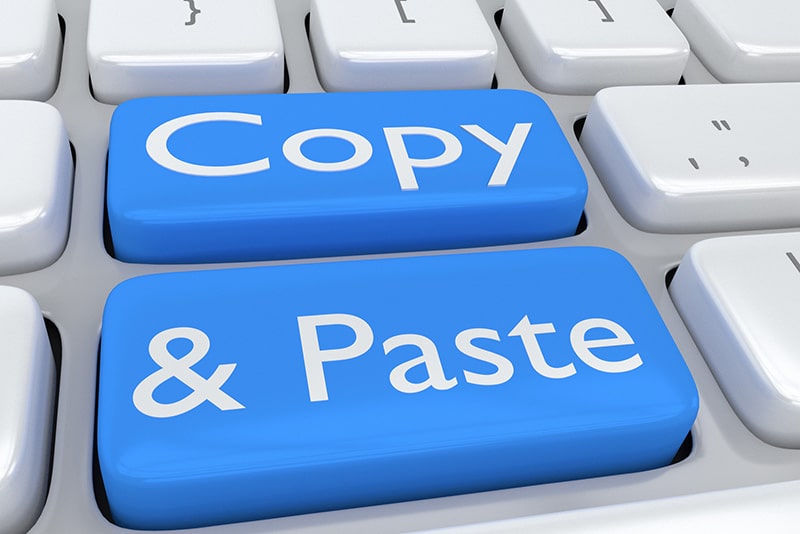
Table of Contents
Documentation integrity refers to the accuracy of the complete health record. Clear, consistent, complete, precise, reliable, timely, and legible electronic health record (EHR) documentation is necessary to reflect the patient’s disease burden and the services provided. Outsourcing medical transcription goes a long way when it comes to maintaining error-free medical records. Dictation and transcription are used alongside structured templates. When physicians enter patient encounter data into EHRs, they tend to use the copy-paste function to overcome the clerical workload and save time. However, if not used judiciously, copy-paste can cause documentation errors and negatively impact patient care.
Uses and Risks of the EHR Copy-and-Paste Function
Physicians who use copy and paste experienced less burnout symptoms, according to a study published in the Journal of the American Medical Informatics Association. The EHR copy-paste function serves several important purposes:
- Improves efficiency by allowing physicians to quickly and easily transfer relevant information from one part of a patient’s EHR to another, eliminating the need for manual typing.
- Promotes consistency in the data and documentation across a patient’s record, maintaining accuracy and minimizing errors.
- Supports complete documentation of a patient’s history, symptoms, treatment plan, and other key details, avoiding the need for rewriting the information.
However, copy-and-paste can easily introduce and propagate errors into the medical record. Indiscriminate copying and pasting can result in inaccurate, redundant, or outdated information becoming part of the permanent medical record, say experts. Potential risks associated with EHR copy-and-paste practices include:
- Copying and pasting information that is inaccurate or outdated
- Superfluous information in the EHR, which makes identifying current information a challenge
- Not being able to identify the author or intent of the documentation
- Inability to identify when the documentation was created
- Propagation of incorrect information – errors may be repeated in the record for months and even years
- Inconsistent progress notes
- Note bloat or progress notes that are too lengthy, making it difficult for future members of the care team to analyze the details of a patient’s medical care
Despite these risks, the Medscape study notes that many physicians continue to overuse copy and paste. A 2022 JAMA study found that, on average, half the clinical note at one health system had been copied and pasted.
Physicians who misuse the EHR “copy-and-paste” feature can face lost hospital privileges, fines, and malpractice lawsuits. A recent Medscape article reported that locum tenens physician in California lost her hospital privileges after her repeated violation of the copy-and-paste policy impaired continuity of care. Another study reported that approximately 2.6% of documentation errors related to note templates, EHR-featured text auto-population, and copy-and-paste functions lead to serious medical issues for patients (Tech Innov Patient Support Radiat Oncol., 2024).
So, what’s the way out? Is it to disable the copy-paste function? No, say experts.
“There’s no question that copy-and-paste can be misused or overused, but it’s also a helpful function for reducing burden when it’s appropriately used, says Dr. Christopher Longhurst, chief information officer at UC San Diego Health. “There’s a place for it, and turning it off completely is not helpful.” (www.modernhealthcare.com).
Best Practices for Safe Use of Copy-and-Paste
Steps that physicians can take to promote safe use of copy-paste, including recommendations from the American Health Information Management Association:
- Establishing policies on where copy-paste can be used and where it cannot to assure compliance with governmental, regulatory and industry standards.
- Address copy-and-paste utilization in the organization’s information governance processes and monitor physician adherence to the policies.
- Encouraging physicians to adequately edit the copy-pasted information to ensure it is still up-to-date and relevant for the patient’s current care.
- Train and educate all EHR system users on proper use of copy-and-paste.
- Establish corrective action as needed.
Monitoring of Copy-and-paste Use
Hospitals and health systems can periodically audit medical records for excessive copy-paste use, recommends the Medscape report. This includes penalizing physicians for overusing copy and paste. Many institutions have taken a proactive approach to managing the use of copy-and-paste functionality within their electronic health records (EHRs).
Banner Health in Arizona, Northwell Health in New York, and University of Toledo in Ohio have introduced formal policies with regards to how physician can copy and paste. Santa Rosa Memorial allows some copy-paste, but has a specific policy which bans using it for the chief complaint, the review of systems, the physical examination, and the assessment and plan in the medical record, except when the information can’t be obtained directly from the patient. Geisinger Health in Pennsylvania regularly monitors and tracks the frequency and patterns of copy-and-paste usage among its physicians, according to a 2022 presentation by a Geisinger official,
The bottom line: Organizations can direct physicians on the use of this EHR function and discipline them for copy-and-paste abuse. Leveraging medical transcription services can help with EHR documentation, allowing providers to focus on the patient during the office visit. With EHR voice-recognition software, physicians can directly dictate into the system and have an experienced medical transcription company review the automated notes for accuracy.


